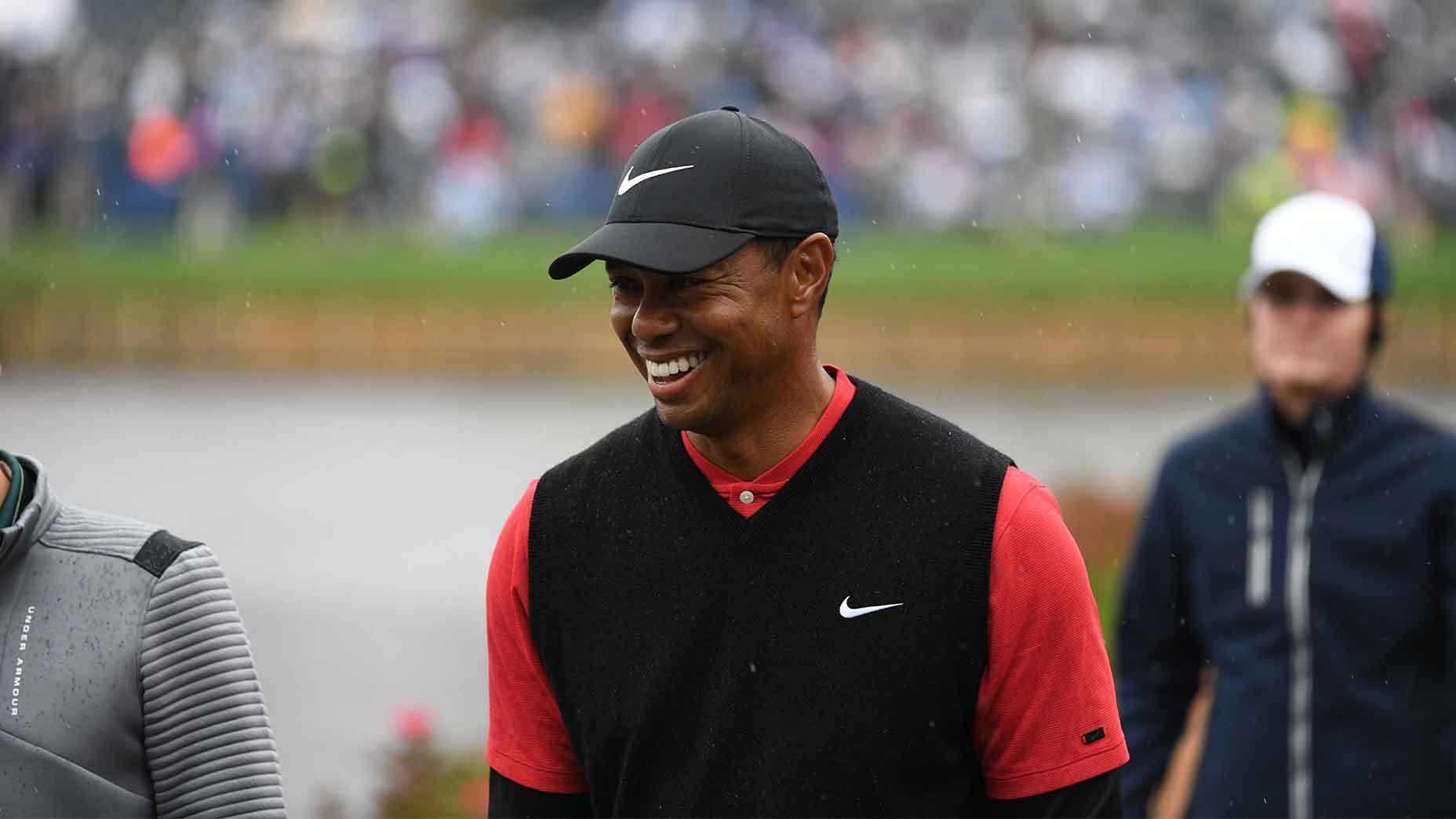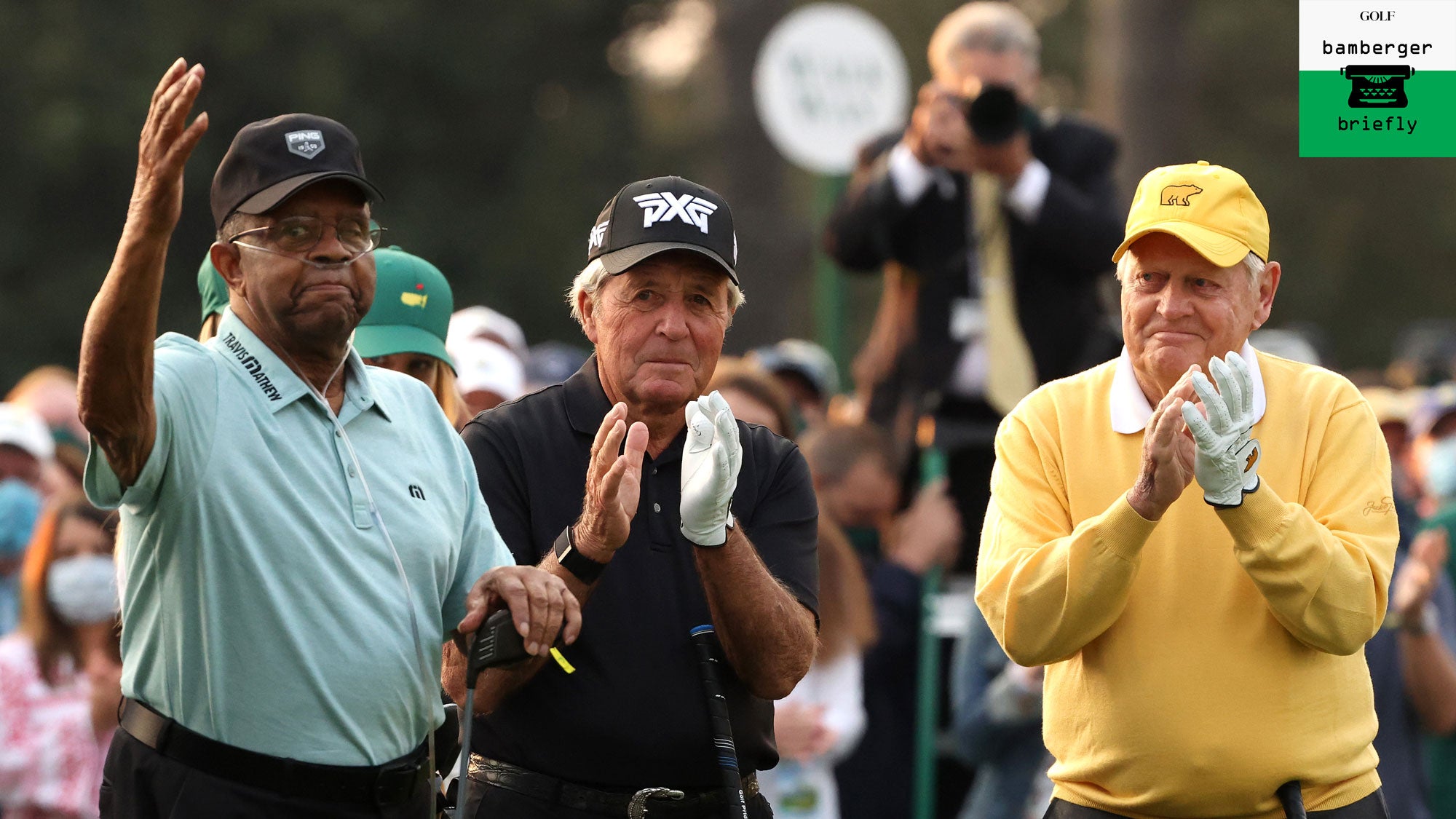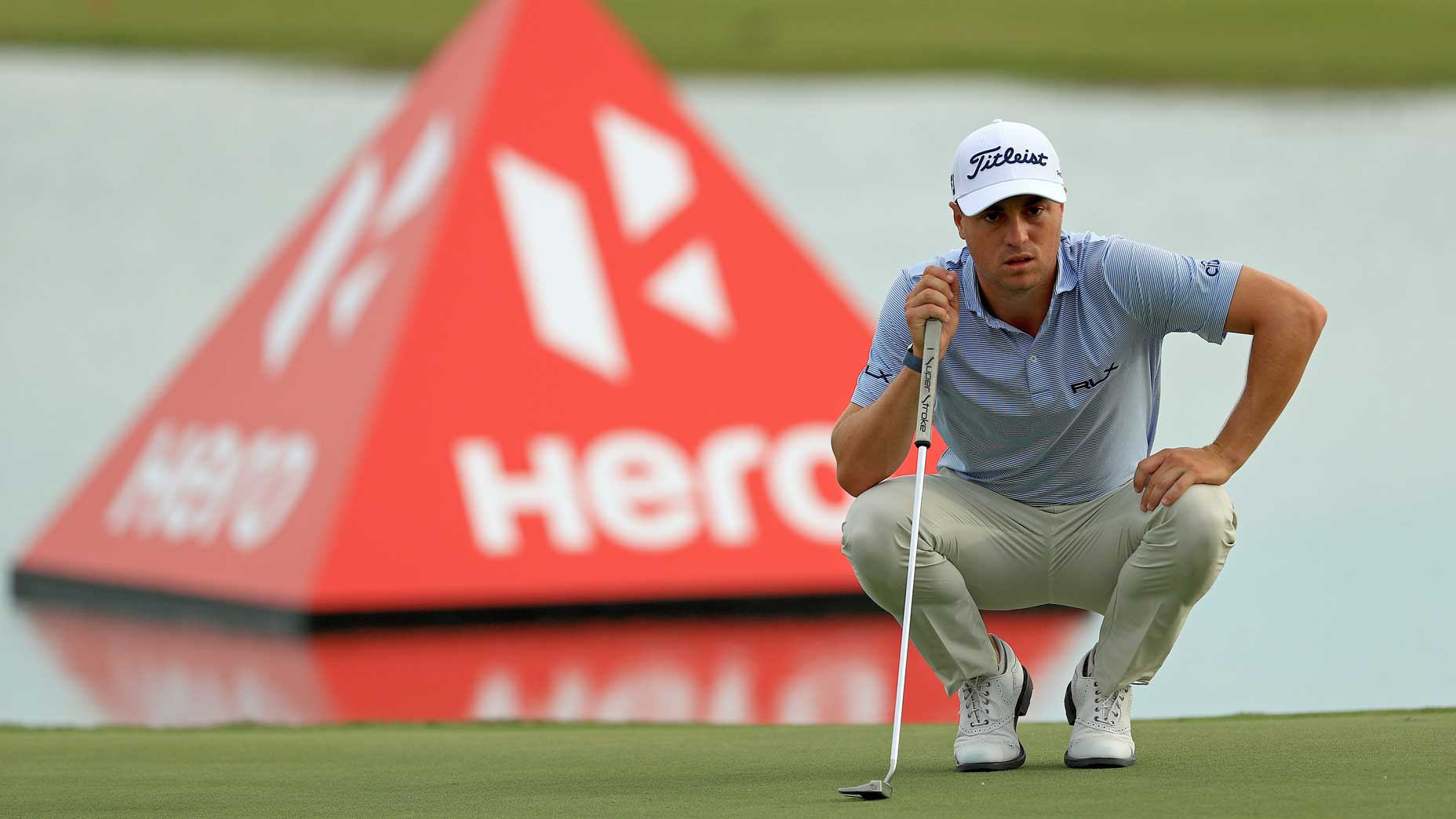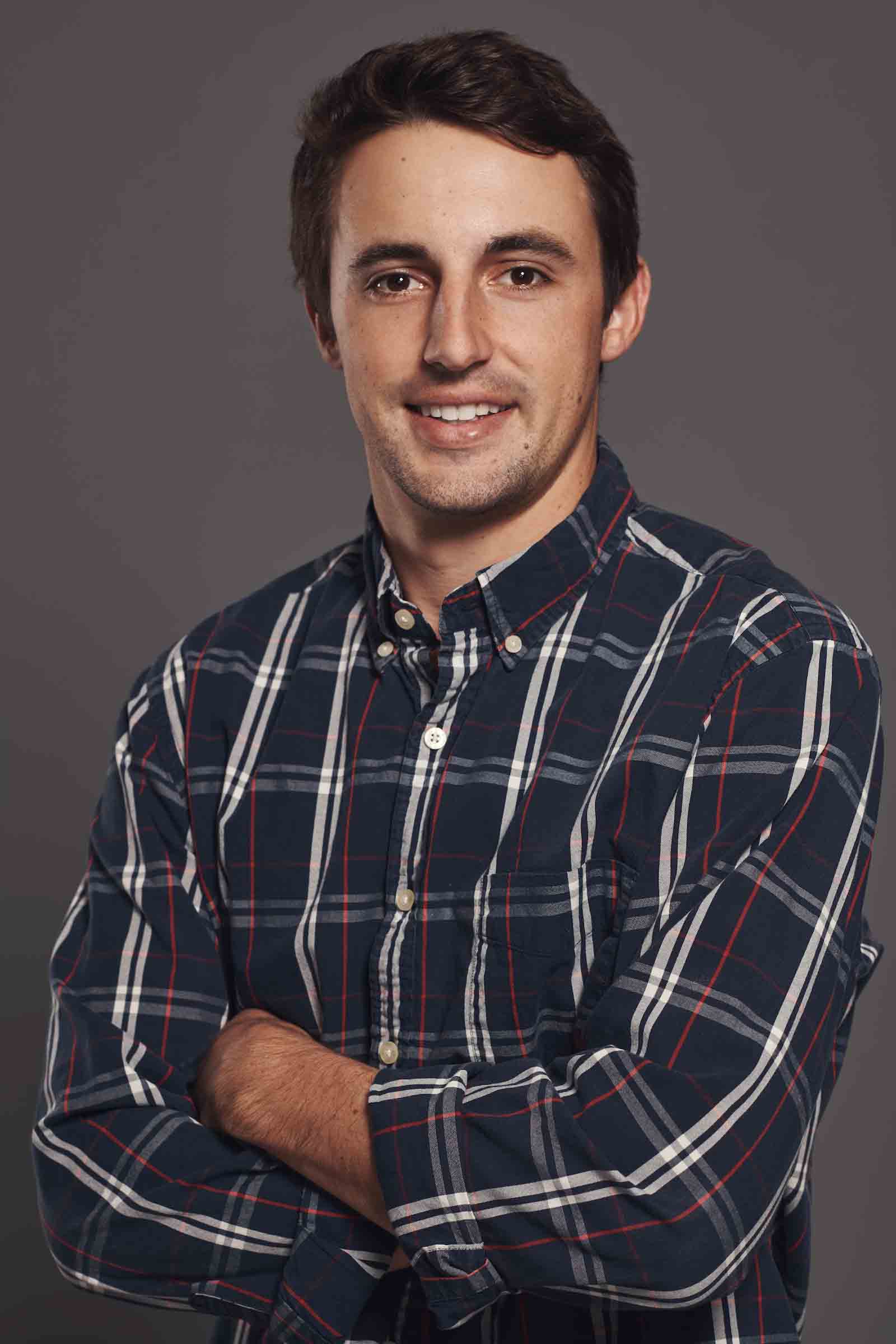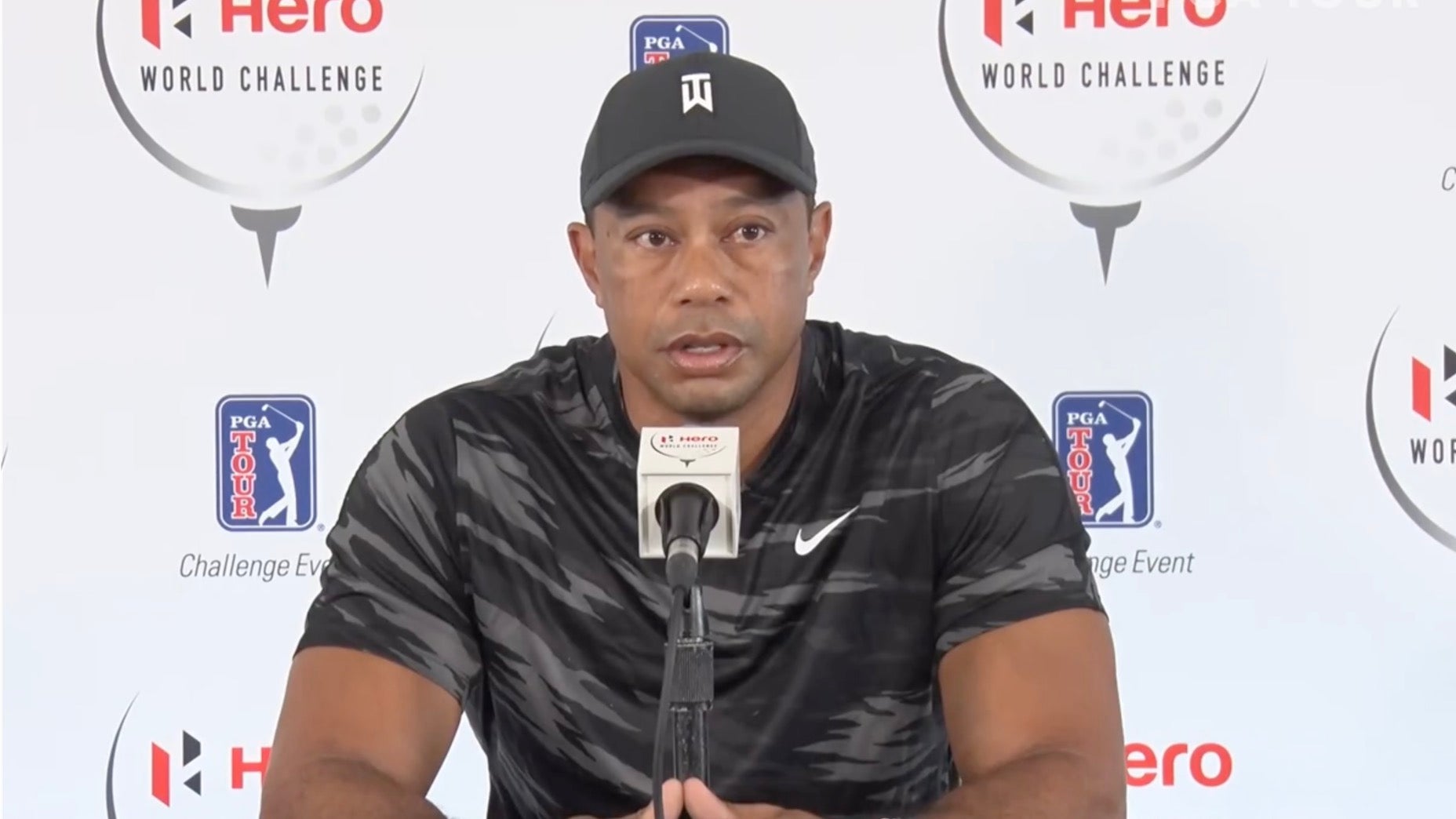
Tiger Woods spoke to the media on Tuesday in the Bahamas.
PGA Tour
NEW PROVIDENCE, Bahamas — How much are we entitled to know about the private life of a public athlete? About a public crash? About a private recovery?
All was quiet on Tuesday morning at Albany. It was 65 degrees at dawn, the type of winter cold front that had the locals bundled up. The sun was doing battle with a group of puffy clouds. It seemed to be winning. Groups of members and guests checked in at the front entrance, picking up goodie bags, loading bags on carts, blading wedges, prepping for a 10 a.m. shotgun start. The scene was tranquil. Controlled.
There was only slightly more urgency in the media center, a modest tented structure located an 8-iron from the driving range. Producers straightened the tablecloth on the press conference setup at the front of the room. Three microphones sat atop the table, three chairs sat behind it. A couple dozen reporters, photographers and tournament staff milled around their desks. Some picked at the platters in the corner: bagels and scrambled eggs and assorted fruit. One staffer leaned into the middle microphone, which yielded some feedback. He winced at the noise, then adjusted it. The feedback went away.
“1-2-3-4-5-6-7-8-9-10,” he counted, using his best press conference voice. “Brian Kelly’s new deal with LSU is worth fifffteen million per year.”
Eventually they had the levels sorted, the cameras connected and a path cleared from the room’s rear entrance. Jack Ryan, the PGA Tour official in charge of this week’s press conferences, straightened his navy blazer.
The reappearance of one of the most iconic figures in sports for the first time since a horrific car crash sounds like a dramatic scene. But this is golf, and this is the Bahamas, and this is Tiger Woods’ tournament. There was no paparazzi rush coming.
When 9 a.m. hit, a convoy of Team Tiger golf carts pulled up behind the tent. Mark Steinberg, Woods’ longtime agent, led the way through the door, playing the role of lead blocker in a lime-green Nike polo. Woods’ right-hand man Rob McNamara hung to the side. He wore sunglasses and a white hat with a logo of a red-shirted Woods in mid-fist pump — the sort of hat that will sell out instantly, should the public ever earn the privilege to purchase it.
Between them walked Woods himself, whose frame was straining the limits of a black-and-grey camo-print Nike blade collar. Whatever else is true of Woods’ recent rehab, he hasn’t missed arm day. He strode carefully to the front of the room, aware his stride was under scrutiny. Good news: he moved well, all things considered. He stepped easily onto the stage and took the center seat between Ryan and Hero MotoCorp CEO Pawan Munjal. He gave a slow, panoramic scan of those assembled. And then, for the next 38 minutes, he answered questions.
Big-picture, Woods looked good. He moved well. He was clear and alert. He locked in on every question. And three points stuck out from his answers.
First, that he’s come an awfully long way from that day in February.
“It’s hard to explain how difficult it has been just to be immobile for the three months, just laying there,” he said. He described how thankful he was for his support system, his friends and family, and for the medical team who had worked to raise his spirits. “There were some tough times in there, there were some really, really tough times. The pain got pretty great at times, but they helped me get through it and I’m on the better side of it.”
Woods described his recovery in comprehensive detail, at least by his famously reticent standards. He was in a hospital bed for three months, he said, completely dependent on others, which was a massive mental challenge. The pain was, too. He recounted the milestones he felt along the way, too. He conquered them one by one — the first being from bed to wheelchair.
“You know, eventually I got to a point where they could wheelchair me outside safely and I could feel the sun,” he said. “It’s little things like that added up.”
Next he went from wheelchair to crutches.
“Eventually when I started crutching around the house, I never — I built a really nice house, but I didn’t realize how big it was until I started crutching around.” That got some chuckles.
Woods also grinned when he described how accustomed his kids have become to seeing their father immobile.
“In this case it’s like, back to normal again, Dad’s not able to move,” he said. Dark humor. That was the next step in his recovery, though: rejoining his family in the backyard, and at Charlie’s golf tournaments, and at Sam’s soccer games.
“I’m not the hip, cool dad at times, so I’m trying to keep up with that,” he said, sounding very daddish indeed. “The lingo changes very quickly, so I’m trying to keep up.”
And the little things kept him going, too, like dreaming of a well-struck golf shot or a holed putt.
“It was nice to finally get the boot off and then hit a few putts, but then after hitting a few putts, I realized that, ‘Damn, that ball’s a long way down there, I can’t get it out of the hole.’
“So I had Matthew, who works for me out back, I said, ‘Dude, no more holes, just sand-filled holes, I can’t bend down that far. Little adjustments like that. To be able to go out there and hit old faithful and feel the memories in that putter and then get to a point where I can hit chip shots and realize I could hit that shot and that shot, let me try and hit this one. And my hands and feel started coming back, but then the aches and pains started coming, so back in the ice bath again.”
He’s been through multiple versions of this before: Pain. Patience. Impatience. And little steps to recovery. But the second thing that Woods made clear is that this time feels different. He’s never coming all the way “back.” Not again.
“I’ll put it to you this way: As far as playing at the Tour level, I don’t know when that’s going to happen,” he said. He joked at his own expense about moving to the forward tees. He spoke with longing about playing at St. Andrews at The Open next summer. But he also acknowledged there are realities he can’t ignore.
“I don’t foresee this leg ever being what it used to be, and I’ll never have my back to what it used to be, and the clock’s ticking,” he said. “I’m getting older, I’m not getting any younger. All that combined means that a full schedule and a full practice schedule and the recovery that it would take to do that, no, I don’t have any desire to do that.”
That word was notable: desire. A former version of Woods may not have acknowledged that there was something he could do but didn’t want to. That’s not how he appears to be wired. But reality can change your wiring, and his got jolted in a hurry. Plus, Woods has gained a mastery of managing expectations. It’s not like he’s giving up altogether.
“To ramp up for a few events a year as I alluded to yesterday as [Ben] Hogan did, he did a pretty good job of it, and there’s no reason that I can’t do that and feel ready,” he said. “I may not be tournament-sharp in the sense I haven’t played tournaments, but I think if you practice correctly and you do it correctly, that I’ve come off surgeries before, I’ve come off long layoffs and I’ve won or come close to winning before. So I know the recipe for it, I’ve just got to get to a point where I feel comfortable enough where I can do that again.”
Those certainly aren’t the words of a man resigned to a lifetime of Father-Son Challenges. The man certainly isn’t throwing in the towel. He said he and his family had discussed the possibility of his return to playing the PGA Tour. Everyone encouraged him to do so.
“I’ll keep all of you abreast as progress continues to go on, whether I’ll be out here and at what level and when,” he added.
That part probably wasn’t true. But it was a nice sentiment.
That gets to his third point, and to my original question: What are we entitled to know? What is Woods obligated to share?
He made it pretty clear early in the presser what he thinks: When it comes to the details of that particular day, not much.
“Yeah, all those answers have been answered in the investigation, so you can read about all that there in the post report,” he said.
That’s demonstrably untrue given the accident reports actually yielded very little in the way of answers, particularly to the biggest question of all: What happened? But if you take “all those answers” to mean “all the answers I’m interested in giving,” it makes slightly more sense.
There’s one school of thought that sees questions about the accident as invasive and nosy; what business is it of ours? Woods was involved in a single-car accident in which nobody else was harmed. His experience and recovery are personal; his status as a public figure is irrelevant here and what came before or after is no business of ours. Plus, why would he say anything that could complicate the now-closed investigation into the crash?
The counter to that is an uncomfortable one: Woods only injured himself, but could easily have injured others. His exact same actions could have yielded a completely different result had there been another vehicle traveling in the opposite direction at the wrong time. He has now been in multiple single-vehicle incidents and the public deserves answers on why that is, and a deferential press room doesn’t get the answers we deserve.
It’s tough to differentiate between what we’re curious to know and what we’re entitled to know. Some public figures would let us in because they would enjoy sharing. Woods is not one of them.
Asked if he ever thinks about the crash or the day, he chose concision again.
“I don’t, no. Very lucky in that way,” he said. Next question.
At the end of the presser I got the chance to ask one more question, so I posed the question to Woods himself. Does he feel the crash is his business and not the business of the general public?
“Well, I kind of feel that way with most of my life. Doesn’t really work out that way,” he said. He paused, then continued, explaining that he’d tried to keep himself away from any coverage of the accident.
“I had friends that insulated me from a lot of the things that were said outside,” he said. “I didn’t have my phone, I didn’t have access — well, I did have access to a TV, but I was just watching sports. But I refused to turn on the local channels and news and stuff like that, I didn’t want to go down that road. I wasn’t mentally ready for that road yet. A lot of things in my body hurt at that time and whether I was on medication or not, it still hurt. And just trying to imagine me coming off of that stuff, how much it was going to hurt, I didn’t want to have my mind go there yet, it wasn’t ready.”
He was only sort of answering my question, but he was answering a different one. He was admitting fear, and pain, and fear of pain. It was a vulnerable moment, but just a moment, before he snapped back to the crux of his point.
“Yeah, people are going to poke and prod and want to know more about my business, I understand that. They can poke and prod at me all they want, just stay away from my family.”
He held his stare an extra second at the end, to emphasize the point of those last five words. On the other end of the gaze, I got the message.
A couple minutes later Woods finished his last answer. He walked back to his cart, where he would be whisked off to the next of his day’s duties. The role of playing tournament host, after all, has nothing to do with answering questions about your health.
It’s not clear when we’ll see Woods next. It’s not clear how often we’ll see him going forward. But what is clear is that even this version of Woods, friendly and introspective and vulnerable, won’t say a single thing he doesn’t want to.
While his golf game remains a work in progress, Woods the public figure is undeniably back.


